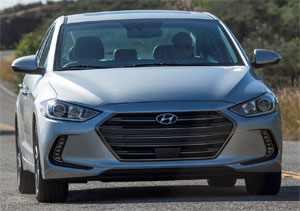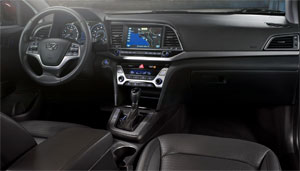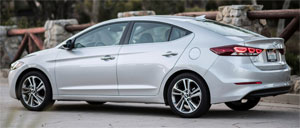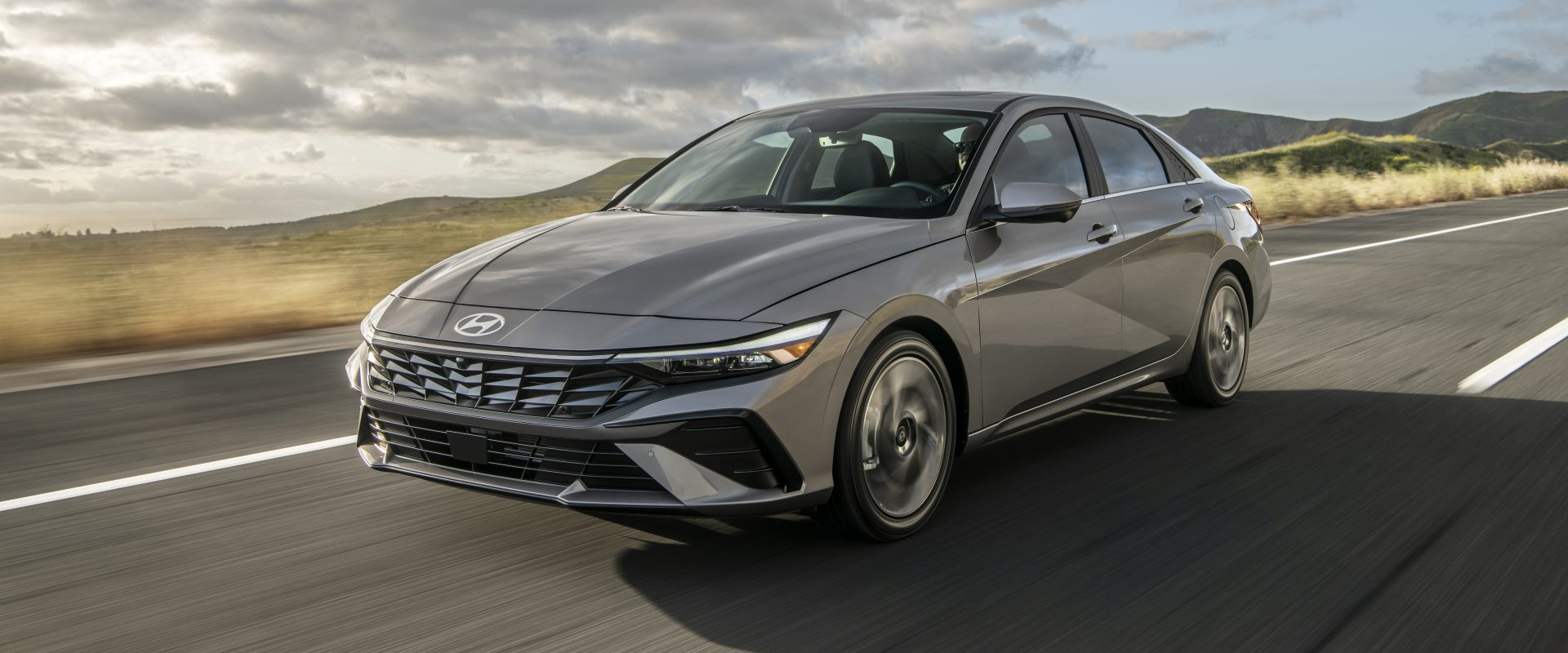2017 Hyundai Elantra
When we last left the Hyundai Elantra, its styling may have impressed us; but when it came to road manners, we thought it was more of a step back in time for this fastly progressing brand. Well, Hyundai certainly hasn’t gotten to where they are today by ending with a cliff hanger. Well, now there’s a new gen Elantra for ’17. So let’s tune in, and find out what happens next.
The Hyundai Elantra sedan has had its ups and downs since going on sale here in the early 90s. And despite our misgivings over the last generation, sales have skyrocketed of late to well over 200,000-units per year. Sounds like a lot, but that’s about 100,000 less than either the Honda Civic or Toyota Corolla. So needless to say, Hyundai is eager to boost their sales further with this 6th-generation 2017 4-door.
Styling is perhaps not as daring as last gen, but it’s still a compact looker and fully in line with larger 4-door stablemates, Sonata and Genesis. Especially up front, where it now shares their larger grille and available signature DRLs.
Same basic platform as before, but it’s had a complete onceover; with a stiffer structure, progressively more isolated suspension, and a modest increase in overall size.
 It’s 1.0-inch wider; and just shy of an inch longer, though wheelbase remains the same. 17-inch alloy wheels come with Limited trim, base SEs are equipped with 15-inch “steelies”.
It’s 1.0-inch wider; and just shy of an inch longer, though wheelbase remains the same. 17-inch alloy wheels come with Limited trim, base SEs are equipped with 15-inch “steelies”.
Most appreciably, things are a lot quieter inside, thanks to thicker glass and additional sound deadening materials.
Helping too is a new, standard 2.0-liter I4 that’s a bit more powerful than the previous gen’s 1.8-liter; at 147-horsepower and 132 lb-ft. of torque.
It’s smoother, quieter operation is readily apparent at cruising speeds. A 6-speed manual transmission is available, but only in base SE trim. A 6-speed automatic is fitted to our Limited tester.
A 128-horsepower 1.4-liter I4-powered Eco model is also available for maximum efficiency, up to 40-highway; though truth be told, the 2.0-liter is not bad in that regard either.
2.0 Government Fuel Economy Ratings are 28-City, 37-Highway, and 32-Combined. We averaged a very good 35.6 miles-per-gallon of Regular. Thus the Energy Impact Score is a good one at 10.3-barrels of oil used annually with C02 emissions of 4.7-tons.
 Front seats are plenty wide and offer above average for its class comfort. Likewise in the rear, there’s adult-size room and adequate coziness.
Front seats are plenty wide and offer above average for its class comfort. Likewise in the rear, there’s adult-size room and adequate coziness.
Trunk space is fine at 14.4 cubic-ft., but it’s cheaply finished and the deck lid feels very flimsy. However, we liked the hand-free opening smart trunk.
Limited trim delivers a display audio system with 7-inch touchscreen and Apple CarPlay and Android auto. Adding the Tech package ups it to 8-inches and adds navigation and Infinity premium audio, as well as heated seats.
Gauges are clean and simple with a 4-inch color TFT info display. The interior has definitely moved upscale in appearance, with the Ultimate package adding seat memory plus the latest in safety including blind spot detection, cross traffic alert, and even emergency braking.
Useful room is up too, so like Civic and Corolla, the Elantra is now classified as midsize by the government.
But middling is how we found full-throttle acceleration, taking 9.3-seconds to hit 60 miles-per-hour with lots of 4-cylinder wail. But, acceleration does remain steady; thanks to minimal lag between shifts. So the Elantra feels faster than the numbers; which were 17.3 in the ¼ at 83 miles-per-hour.
 Things certainly have improved in the handling department. There is plenty of grip at a moderate pace; and a playful amount of understeer when pushed harder. The car reacts quickly to steering inputs; and a nicely responsive throttle enabled us to easily keep it right on the edge, inspiring confidence as speeds increased.
Things certainly have improved in the handling department. There is plenty of grip at a moderate pace; and a playful amount of understeer when pushed harder. The car reacts quickly to steering inputs; and a nicely responsive throttle enabled us to easily keep it right on the edge, inspiring confidence as speeds increased.
Brakes were another pleasant surprise. Panic stops from 60 took a good 123–feet with minimal fade; along with a nicely firm, short travel pedal.
So with all of the improvements, the Elantra’s value proposition is also stronger than ever, as base SE pricing is actually reduced by 90-bucks to $17,985. Limited trim starts at $23,185.
Far more competent, more refined, and more consistent with Hyundai’s increasingly upscale ambitions; plus an outstanding warranty; all things that help make the 2017 Hyundai Elantra a vehicle worthy of your compact consideration. One that might finally be ready to give Corolla and Civic a real run for your money.
Specifications
- Engine: 2.0 liter I4
- Horsepower: 147
- Torque: 132 lb-ft.
- 0-60 mph: 9.3 seconds
- 1/4 mile: 17.3 seconds @ 83 mph
- EPA: 28 mpg city / 37 mpg highway
- Energy Impact: 10.3 barrels of oil/yr
- CO2 Emissions: 4.7 tons/yr
- Transmission: 6 spd auto
2024 Hyundai Elantra
Basic Transportation At Its Best…And That Is A Compliment
For those of you who write in every week bemoaning the fact that all we seem to do around here is test incredibly expensive cars and EVs that only the very well to do can afford, this one’s for you. It’s a commuter and budget friendly mainstay from Hyundai, the compact Elantra sedan. And, it has been nicely updated for 2024.
We clearly do enjoy driving high-performance machines and ultra-luxury rides around here, but like most of you, when it comes time to drive home at the end of a long workday, we do so in something much more practical and affordable, like this 2024 Hyundai Elantra sedan.
If you’re thinking the front end has gotten more aggressive, you’re right. Hyundai calls it a “Shark Nose” theme, and we’re guessing they were thinking more Great White than Hammerhead, though Megamouth shark would also apply. It helps for a low and wide look; more substantial than the typical compact. Other additions for ’24 include slimmer daytime running lights, revised stainless steel Hyundai emblem, reshaped front fenders, sport sedan-style rear diffuser with silver trim; a parametric pattern added to the C-Pillar, and new LED taillights that take up a lot more space on the highly sculpted decklid. Plus, new wheel designs in sizes ranging from 15- to 18-inches.
Standard engine in SE, SEL, and Limited grades is this naturally aspirated 2.0-liter I4 with 147 horsepower and 132 lb-ft of torque. Even with no hybrid assistance, it gets substantial Government Fuel Economy Ratings of 31 City, 40 Highway, and 34 Combined; we averaged a great 38.6 mpg of Regular.
Those high fuel economy numbers mean acceleration times are pretty high as well. It was in no particular hurry to get off the line at our test track, as after a slight jolt of power, it felt pretty sluggish going down the track, taking us a lengthy 9.4 seconds to hit 60 mph. Hyundai’s Intelligent Variable Transmission has some realistic simulated gear shifts built in, and they not only provided the feel of a true automatic, but kept engine noise from becoming overbearing. And while this 2.0-liter may not be a house-on-fire off the line, it has no problem keeping up with traffic, and feels like just the perfect amount of power for a practical and safe commuter car.
There are other engine options too. Two choices if you want to go faster, a 1.6-liter turbo with 201 horsepower in the Elantra N Line, and a 276-horsepower turbocharged 2.0-liter for the Elantra N; plus, one with even better fuel economy, a 1.6-liter hybrid with a 139 horsepower total output.
And despite some significant understeer, there was good feel through the cones of our handling course, both in steering and chassis feedback. We wouldn’t quite call it “point and shoot,” but it responded to inputs fairly quickly, with only moderate body roll. All-in-all, when it comes to performance, it doesn’t claim to bring a whole lot to the table, but does clearly overachieve with what it does bring.
And Hyundai is always overachieving when it comes to packing in features, yet has found a way of keeping things refreshingly simple with a good mix of touchscreen and manual controls. Lots of space too, both up front in the surprisingly wide front buckets, and in the rear bench with ample room for three. Updates for all Elantra interiors include softer materials on the door panels, upgraded instrumentation and additional charging ports, plus a surround view monitor and new H-Tex simulated leather for Limited trim.
Elantra pricing starts with an SE at $22,775, the SEL comes in at $24,725, Limited begins at $28,215, and the sporty N Line starts at $29,615. If you’re interested in the hybrid, base Blue starts at $27,400 with Limited at $30,600.
Some might say there’s not a whole lot that’s earth shaking about the 2024 Hyundai Elantra, but that’s mostly why we like it so much. When it comes to just delivering good, basic transportation with a high dose of unexpected amenities, Hyundai delivers once again.
Specifications
- Engine: 2.0-liter I4
- Horsepower: 147
- 0-60 mph: 9.4 seconds
- 60-0 Braking: 111 ft (avg)
- MW Fuel Economy: 38.6 MPG (Regular)
- Transmission: IVT
- Torque: 132 lb-ft
- 1/4 Mile: N/A (Track Maintenance)
- EPA: 31 City / 40 Highway / 34 Combined







